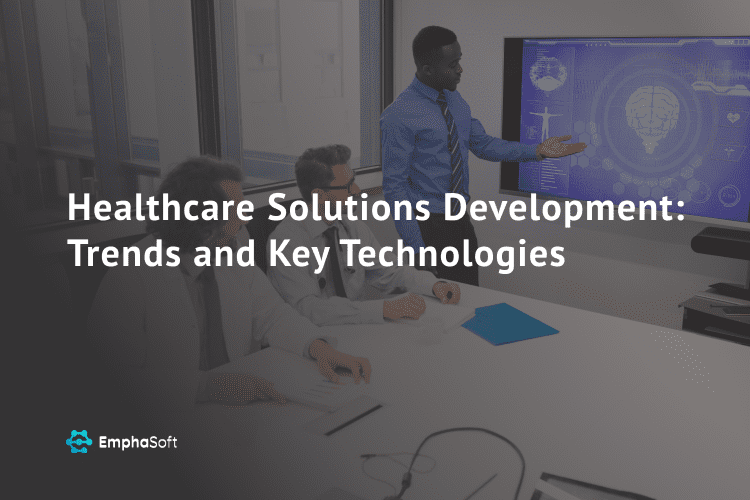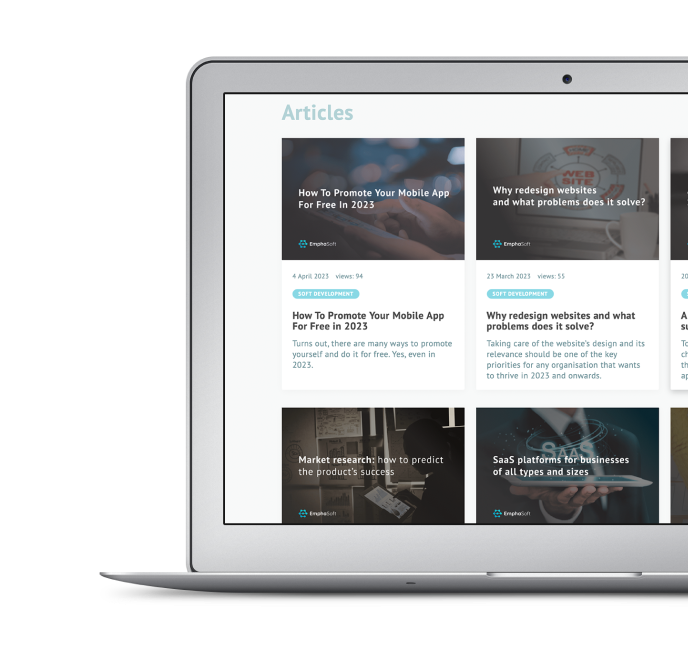The years of pandemic have shown us how fragile the healthcare system really is. Global medical staff shortage paired with ever-decreasing budgets for the public sector mean that we need to be creative and come up with ways to make the most of what we have to help patients without overwhelming doctors and nurses.
One of the ways to do that is through smart healthcare technology.
Today we’ll look into current trends and challenges associated with health tech, learn about the development process of medical solutions, see what is currently utilised in the field, and go through the key benefits of using medical software for startups.
Emerging trends in healthcare
A lot is happening in healthcare right now, but there are several trends that arose not that long ago and are set to redefine the way we view medical services.
#1 Telemedicine and virtual care
Both telemedicine and virtual care open phenomenal opportunities to treat people with limited mobility, those who live in remote locations, or someone who is taking care of a family member and cannot leave the house for an extended period of time.
The remote care trend was already gaining momentum prior to 2020, but it is the pandemic that has given it a huge boost and normalised the format for millions of people. The telehealth industry in the US alone exceededhttps://www.grandviewresearch.com/industry-analysis/us-telehealth-market 29 billion in 2022, and the virtual care market was valued at 4 billion in 2021.
There are still many legal restrictions and potential ethical issues that need to be considered before telemedicine can properly move forward. Yet, it’s clear that we must implement it one way or the other because the need is there. With the population growing while the number of doctors is declining, virtual care is a reasonable way to move forward and cater to as many patients as possible.
#2 Remote patient monitoring and wearable health tech
According to Fortune Business Insights, the market size for wearable medical devices reached 59 billion in 2022 and is projected to grow up to 73 billion by the end of 2023, and to an astonishing 428 billion by 2030.
Consistent health monitoring saves lives. Before technological advances, doctors had to rely on patients’ discipline to come in for regular check-ups, and if anything abnormal happened in between those visits – there was no way to know and minimise the damage.
That’s why wearable health tech and the remote monitoring possibilities it unlocked are so revolutionary. People with chronic diseases and the elderly now have a chance to have a better quality of life. As for medical staff, statistics they pull from the wearables provide them with a much more detailed and, more importantly, data-driven picture of what is happening with their patients.
#3 AI-driven diagnostics and predictive analytics
AI is quickly becoming an integral part of our lives, with the medical field being no exception. Prior to the ChatGPT boom, AI was already heavily utilised in medical research, helping scientists scan and analyse data faster, and reducing the simulation period from months to days. AI was even instrumental in developing the Moderna vaccine during COVID.
But it’s not just research that AI enhances. It is also beyond helpful to automate some of the treatment elements, such as the ultrasound results interpretation. AI doesn’t get tired and can scan much more data than a human doctor would. There is a lot of investor interest in this particular use of AI because, if everything works well, we can reduce waiting time by weeks and months, helping people get their much-needed diagnosis faster and start treatment without unnecessary delays.
#4 Blockchain in healthcare for secure data sharing
When we talk about technology in healthcare, it is impossible not to mention data protection. Even the best software out there can have vulnerabilities that criminals will gladly utilise in stealing patients’ data.
Four out of 10 US consumers of wearable tech are concerned with data privacy, and the number rises to 60% of consumers who sign up for reporting and analysis solutions for their data. And people are right to worry. In March 2020, the US-based prescription management solution Walgreens was breached, leading to customers’ full names, addresses, and prescriptions being leaked. The vulnerability was quickly fixed, but 72,000 clients were believed to be affected.
In 2021, healthcare-related data breaches impacted a total of 45 million people. Data theft is a huge risk to the entire industry, that’s why many startups and established companies are in a race to come up with the most secure way to handle patient data. That’s where blockchain comes into play. Considered one of the safest data-handling technologies today, blockchain is the hope of secure medical data sharing.
Current challenges in healthcare
The state of global healthcare today is not at the level that we all want it to be. Rising healthcare costs, concerns over patient data security, inefficiencies across all medical fields, – those are just a few examples of the challenges that every society faces and has to deal with.
Technology can be the answer to many of those issues, but it’s not that simple. Dealing with people’s health is extremely important, and there is no room for error. New solutions entering the market often deal with scepticism, and they get scrutinised for any little mistake they allow.
And if the technology works well, and the public is willing to accept it, there is another issue of regulatory compliance. While a good thing, regulations often slow down or cancel out the progress that is made because they’re too slow in adapting to new ideas,, and tend to prohibit initiatives rather than dive deep and understand them.
Yet, despite all the challenges that health tech faces, this is a highly rewarding industry to operate in. Not only do you get a chance to make an incredible difference in the lives of thousands of people, but you also get to unleash your creative potential and work on some of the most complex issues.
What is the healthcare software development process?
In terms of the software development process, health tech doesn’t look much different from any other industry. There are many more approvals and trials are longer, but the development itself is pretty standard.
Here are the key steps that the Emphasoft team takes:
- Market research and needs assessment. It all starts with a market analysis that identifies healthcare needs and gaps that we can fit with the software solution. At this stage, healthcare professionals and stakeholders are heavily involved in brainstorming and decision-making.
- Conceptualisation and planning. Once the general direction is clear, it’s time to define the scope of the solution. For example, mobile vs web platforms. Here we create a detailed project plan, including the approximate list of features and functionalities, and user experience design.
- Technology stack selection. The next step is to define what the future solution will be built with. At Emphasoft, we have a strong team of diverse specialists, so the tech stack choice is not limited by our capabilities but rather is made depending on what’s best for the particular solution. Here we choose appropriate programming languages, frameworks, and tools. For healthcare applications, we always evaluate databases, cloud platforms, and security protocols closely.
- User-centric design. Design is key to the success of the solution. Neither doctors nor patients will tolerate poor and cumbersome design unless your app solves a highly critical issue and there is no competition. But even if that’s the case, why make users suffer with bad design choices? The interface has to be straightforward and intuitive, especially in the medical field where making a mistake or missing an important data point can lead to devastating results. Design is tracked and improved throughout the development process with the help of iterative prototypes and user tests.
Key benefits of healthcare solutions for startups
Healthcare startups can really benefit from utilising solutions that enhance and support their operations. Here are some of the main benefits that the Empahsoft team discovered through working with many medical startups over the years.
Improved patient care
Unlike human beings, tech is much more reliable and less likely to forget about something. For patients, this means they get timely notifications and interventions that proactively support their well-being and help spot a potential issue before it turns into a disaster. Remote monitoring, in particular, has helped tens of thousands of people stay healthy longer and avoid medical complications simply with timely reminders and non-stop health tracking.
Better operational efficiency
Personal contact and custom approach are extremely important in healthcare. However, there are countless little tasks that can and should be automated. Scheduling and billing, for instance, take a lot of time and effort from the staff but the software can do it just as well if not better. With less time wasted on mundane tasks, employees have more time and energy to dedicate to patients and important projects that are often postponed because nobody has the bandwidth to deal with them.
The benefit of automation is also applicable to patients. With the help of technology, they spend less time worrying about their medical state. Health issues are scary, so the more we can offload from our patients’ shoulders, the better. With robust software in place, there is no risk of human error, which is very reassuring for patients and can be the difference between them staying with your company or going to competition.
Smarter decision-making process
Technology is often linked with data, and the medical sector is no exception. Automating your operations and storing all information in a digital format means easier monitoring and reporting.
Analysing data is critical for trend and issue spotting. It is also a great way to verify that the changes you apply to your organisation are working. Having reports and running predictive analytics helps plan better. If reports show that demand for a specific specialist or procedure skyrockets every spring, the clinic can hire extra doctors, extend working hours, or run promotions to make the most of the situation. Reports will also show your administrators when it’s time to top up inventory and what resources are always left in stock and should be ordered at a smaller scale next time.
Final thoughts
Healthtech continues to be one of the most promising industries in the IT world. Even with high entry barriers and longer development and approval timelines, healthcare technology continues to attract both investors and startups. Valued in tens of billions of dollars, the global market has lots of potential to build successful companies and to change the trajectory of how patients are treated in the modern world.
Read next:
Physician AI and scribe system: New era patient care management system
Biometric security: The Future of Authentication

Scale faster with quality tech expertise
The years of pandemic have shown us how fragile the healthcare system really is. Global medical staff shortage paired with ever-decreasing budgets for the public sector mean that we need to be creative and come up with ways to make the most of what we have to help patients without overwhelming doctors and nurses. One of the ways to do that is through smart healthcare technology.








 Schedule a Discovery Call
Schedule a Discovery Call Schedule Call
Schedule Call